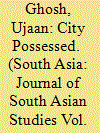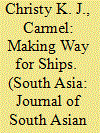| Srl | Item |
| 1 |
ID:
188403


|
|
|
|
|
| Summary/Abstract |
The mid twentieth-century Bengali ghost story has a distinct urban form. From haunting Gothic mansions, ominous bungalows and thickets of trees, the ghosts of mid twentieth-century fiction show up in the streets of Calcutta, on motorised omnibuses, in urban movie theatres and even selling cocaine in the docks of the city. In this paper, I explore why Bengali ghost stories in the twentieth century predominantly choose the city as a motif to situate their hauntings. I analyse two spectral texts from the mid twentieth century, ‘Kankal Sarathi (The Skeleton Chauffeur)’ by Hemendra Kumar Ray (1888–1963) and ‘Andhakre (In Darkness)’ by Sharadindu Bandyopadhyay (1899–1970), and juxtapose them alongside the official urban archive. Significant changes took place in Calcutta’s urban planning at the turn of the twentieth century. Committed to ‘improving’ the city, planners sought large-scale demolitions of existing buildings, which resulted in massive displacement of individuals and communities. Historians have recorded the deep disquiet these changes induced in the city’s inhabitants. What I demonstrate are the ways in which ghost stories responded to these infrastructural alterities. Spectral narratives emerged as a new literary strategy through which the city’s new journey towards infrastructural modernity was critiqued. The larger methodological question I wish to explore is whether it is possible to treat the genre of horror as an extended archive of historical inquiry.
|
|
|
|
|
|
|
|
|
|
|
|
|
|
|
|
| 2 |
ID:
188406


|
|
|
|
|
| Summary/Abstract |
This article foregrounds the interlinkages between the urban space-making of Kochi, religion and the displacement of shore communities in the decades after the Independence of India in 1947. I analyse the happenings and narratives around post-Independent India’s development initiatives as a site to understand space, land and sea as crucial resources in relation to the development of the city and the displacement of the shore communities. Specifically, I examine how the establishment of the Cochin Shipyard, a public-sector company which builds and repairs ships, is entangled with displacement and religion in the development history of Kochi, a comparatively small port city on the south-western coast of the Indian subcontinent. I also trace the refiguring of the displaced people’s land as the place of ‘revengeful ghosts’ in vernacular literature, which, I argue, shows anxieties about the unjust treatment of the evicted communities. I use a diverse range of sources including newspaper reports, biographical notes, ethnographic accounts, myths and literature to recreate this forgotten chapter in the development of Kochi.
|
|
|
|
|
|
|
|
|
|
|
|
|
|
|
|